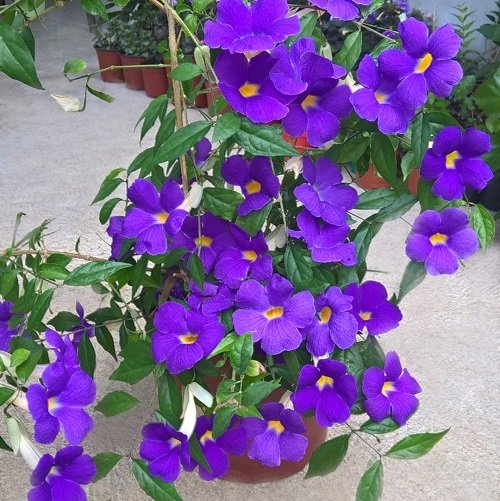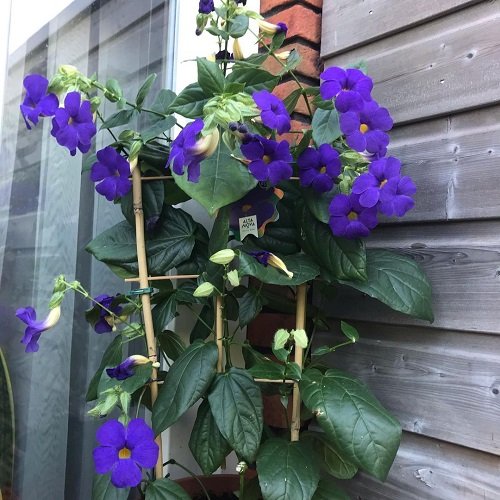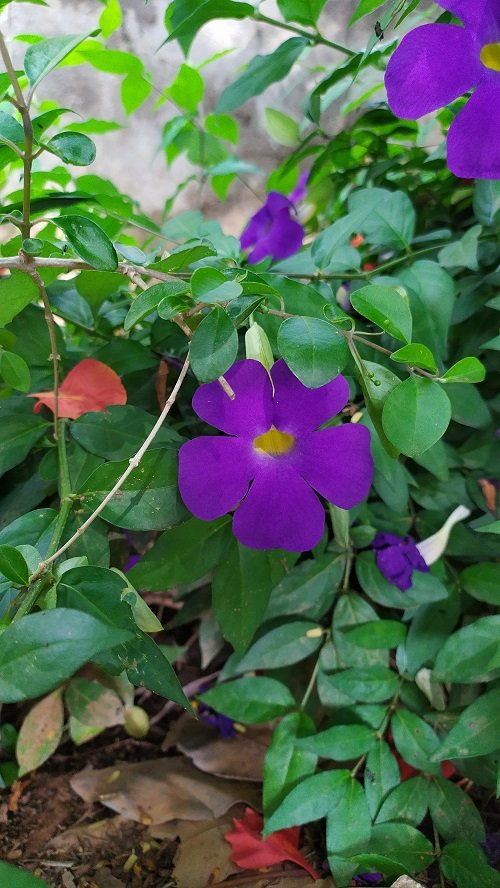Thunbergia Erecta showcases beautiful purple-blue flowers and can be a great addition to the garden! Learn how to grow it easily!

Thunbergia Erecta is quite a versatile specimen that you can grow both in gardens and pots to have a purple blossoming appeal! Let’s have a look at how to grow Bush Clockvine.
Check out the best thunbergia flowers
Thunbergia Erecta Plant Information
Also popular as king’s mantle and potato bush, Thunbergia Erecta is a herbaceous climbing perennial from western Africa. This woody, upright shrub grows up to 4-6 feet tall and showcases small, ovate leaves.
The ornamental tubular purple-blue blooms have a sweet scent and appear from early summer to early fall (June to September).
Have a look at the Best Plants For Hanging Baskets
Propagating Thunbergia Erecta

Propagation by Seeds
Sow seeds in well-draining soil, water well, and keep the pot where it gets plenty of bright but indirect light. The seeds will sprout in 3-5 weeks.
Propagation by Cuttings
Begin propagation from mid-spring to early summer by taking 4-6 inches-long cuttings. Dip the end in a rooting hormone and plant it in well-draining soil. Water well and keep the pot in bright and indirect light.
Check out the best Types of Violet Flowers
Requirements for Growing Thunbergia Erecta

Location
Thunbergia Erecta can handle a bit of shade, but in that way, this plant won’t flower as much. If you want the best growth, make sure it gets a minimum of 4-6 hours of bright sunlight. This will really promote plentiful blooms with a signature deep purple-blue hue.
Soil
This plant prefers a well-draining soil with a pH of 6.0-7.0. Enrich it with organic matter for more benefit. The soil should be kept evenly moist but not soggy. A potting soil mixed with equal parts of compost and perlite or coarse sand will work well.
Watering
They prefer to be watered lightly, about once a week. However, during the hot summer months, they may require more frequent watering.
Allow the top inch of soil to dry between waterings and water around the base of the plant, avoiding wetting the foliage.
Also, make sure your Thunbergia Erecta plant is getting enough light, as this will help to keep it from becoming overly stressed from lack of water.
Look at the Indoor Plants With Purple Flowers
Thunbergia Erecta Care

Fertilizer
Fertilizer for Thunbergia Erecta plants should be applied every 6-8 weeks during the spring and summer months.
A balanced fertilizer with an equal ratio of nitrogen, phosphorus, and potassium (N-P-K) is recommended. A 10-10-10 or 20-20-20 fertilizer should be used at a rate of one tablespoon per gallon of water.
The fertilizer should be applied when the soil is moist and then watered in. It is important to avoid over-fertilizing, as this can cause the leaves to yellow or burn.
Alternatively, you can also use a handful of animal manure, fish emulsion, or leaf molds once in 1-2 months.
Pruning
Pruning Thunbergia Erecta can be done in late winter or early spring. To prune the plant, cut back any dead, brown, or damaged stem tips to encourage new growth. This can be done with a pair of sharp pruning shears.
You can also prune the stems back by about one-third to keep the plant from growing too tall and leggy. Pruning will also help promote abundant flowering. If the plant becomes too large and unruly, you can cut it back to the ground. Be sure to water the plant well after pruning to help it recover.
Pests and Diseases
If you keep the foliage dry and the plant in plenty of sunlight, it will be safe from all the potential pests and disease problems. Whiteflies, scales, and spider mites might attack the plant, and you can keep them at bay using insecticidal soap.


